语义学论文
- 格式:doc
- 大小:55.00 KB
- 文档页数:7
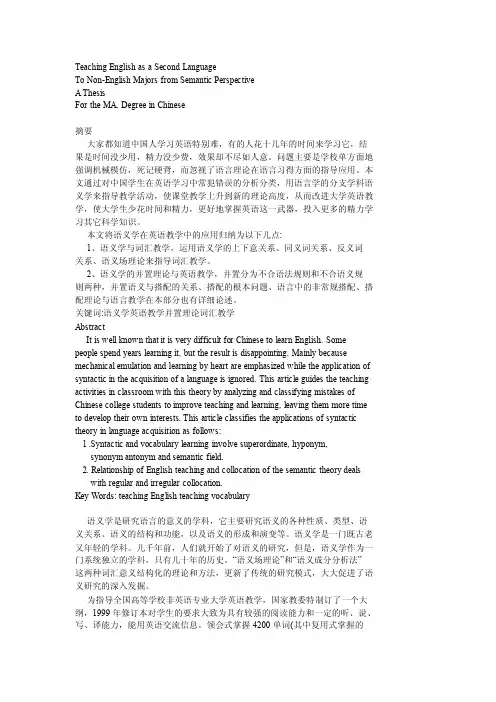
Teaching English as a Second LanguageTo Non-English Majors from Semantic PerspectiveA ThesisFor the MA. Degree in Chinese摘要大家都知道中国人学习英语特别难,有的人花十几年的时间来学习它,结果是时间没少用,精力没少费,效果却不尽如人意。
问题主要是学校单方面地强调机械模仿,死记硬背,而忽视了语言理论在语言习得方面的指导应用。
本文通过对中国学生在英语学习中常犯错误的分析分类,用语言学的分支学科语义学来指导教学活动,使课堂教学上升到新的理论高度,从而改进大学英语教学,使大学生少花时间和精力,更好地掌握英语这一武器,投入更多的精力学习其它科学知识。
本文将语义学在英语教学中的应用归纳为以下几点:1、语义学与词汇教学,运用语义学的上下意关系、同义词关系、反义词关系、语义场理论来指导词汇教学。
2、语义学的并置理论与英语教学,并置分为不合语法规则和不合语义规则两种,并置语义与搭配的关系、搭配的根本问题、语言中的非常规搭配、搭配理论与语言教学在本部分也有详细论述。
关键词:语义学英语教学并置理论词汇教学AbstractIt is well known that it is very difficult for Chinese to learn English. Some people spend years learning it, but the result is disappointing. Mainly because mechanical emulation and learning by heart are emphasized while the application of syntactic in the acquisition of a language is ignored. This article guides the teaching activities in classroom with this theory by analyzing and classifying mistakes of Chinese college students to improve teaching and learning, leaving them more time to develop their own interests. This article classifies the applications of syntactic theory in language acquisition as follows:1 .Syntactic and vocabulary learning involve superordinate, hyponym,synonym antonym and semantic field.2. Relationship of English teaching and collocation of the semantic theory dealswith regular and irregular collocation.Key Words: teaching English teaching vocabulary语义学是研究语言的意义的学科,它主要研究语义的各种性质、类型、语义关系、语义的结构和功能,以及语义的形成和演变等。
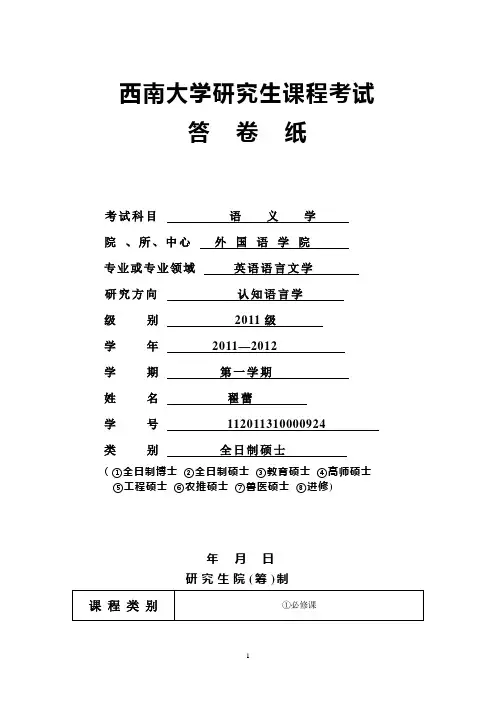
西南大学研究生课程考试答卷纸考试科目语义学院、所、中心外国语学院专业或专业领域英语语言文学研究方向认知语言学级别2011级学年2011—2012学期第一学期姓名翟蕾学号112011310000924类别全日制硕士(①全日制博士②全日制硕士③教育硕士④高师硕士⑤工程硕士⑥农推硕士⑦兽医硕士⑧进修)年月日研究生院(筹)制备注:成绩评定以百分制或等级制评分,每份试卷均应标明课程类别(①必修课②选修课③同等学力补修课)与考核方式(①闭卷笔试②口试③开卷笔试④课程论文)。
课程论文应给出评语。
Abstract:As we all know, preposition is one of the most active word classes with vital significance in both the English and Chinese languages. “C ong” is used frequently in modern Chinese; and in English, “from” is used frequently, too. Having a good master of the respective semantic functions and making cognitive semantic studies of the symmetries and asymmetries of their respective semantic functions without no doubt enable English learners to apply theory into practice and acquire the English usage well.Key words: English preposition “from”, Chinese preposition “cong”, cognitive, semantic function摘要:总所周知,英汉两种语言中,介词均属于最重要的虚词之一。
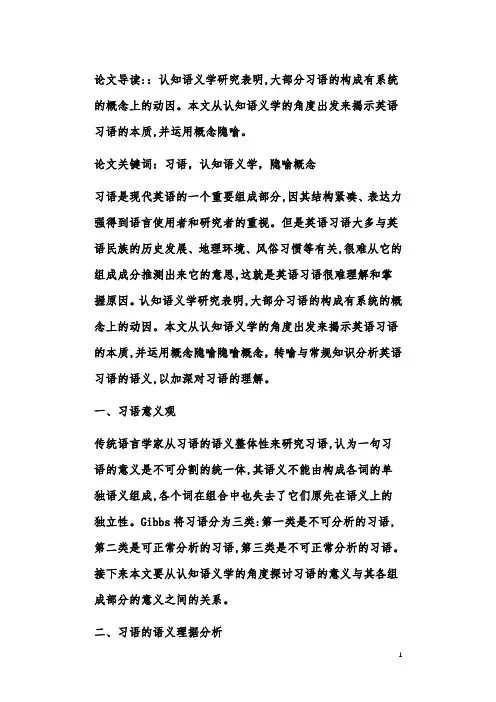
论文导读::认知语义学研究表明,大部分习语的构成有系统的概念上的动因。
本文从认知语义学的角度出发来揭示英语习语的本质,并运用概念隐喻。
论文关键词:习语,认知语义学,隐喻概念习语是现代英语的一个重要组成部分,因其结构紧凑、表达力强得到语言使用者和研究者的重视。
但是英语习语大多与英语民族的历史发展、地理环境、风俗习惯等有关,很难从它的组成成分推测出来它的意思,这就是英语习语很难理解和掌握原因。
认知语义学研究表明,大部分习语的构成有系统的概念上的动因。
本文从认知语义学的角度出发来揭示英语习语的本质,并运用概念隐喻隐喻概念,转喻与常规知识分析英语习语的语义,以加深对习语的理解。
一、习语意义观传统语言学家从习语的语义整体性来研究习语,认为一句习语的意义是不可分割的统一体,其语义不能由构成各词的单独语义组成,各个词在组合中也失去了它们原先在语义上的独立性。
Gibbs将习语分为三类:第一类是不可分析的习语,第二类是可正常分析的习语,第三类是不可正常分析的习语。
接下来本文要从认知语义学的角度探讨习语的意义与其各组成部分的意义之间的关系。
二、习语的语义理据分析习语是认知机制的作用物构成习语的各个词及其句法特征和意义,组成这个习语的形式和字面意义,形成一个或多个概念域。
这种概念域通过认知机制的作用与习语的特殊意义相联系。
在这里起作用的认知机制常常是隐喻、换喻和常规知识等。
2.1隐喻认知作用的习语美国心理学家Gibbs 发现,概念隐喻有心理现实性,正是概念隐喻促使产生了习语表达方式;人们对习语隐喻基础有着心照不宣的知识,人们对理解习语一致性就是概念隐喻作用的结果。
例如:LOVE IS FIRE ----- I amburning with love.概念隐喻在这里作用于两个不同的知识范围,使它们一致起来。
人们可以使用能够直接体验到的、熟悉的东西,来谈论另一个较为抽象的、不大熟悉的东西。
2.2 转喻认知和常规知识作用的习语与隐喻不同,转喻只涉及一个概念域,是人们用熟悉的事物去表征与其相关的事物或用熟悉的一个方面去表征整个事物的一种认知方式发表论文。
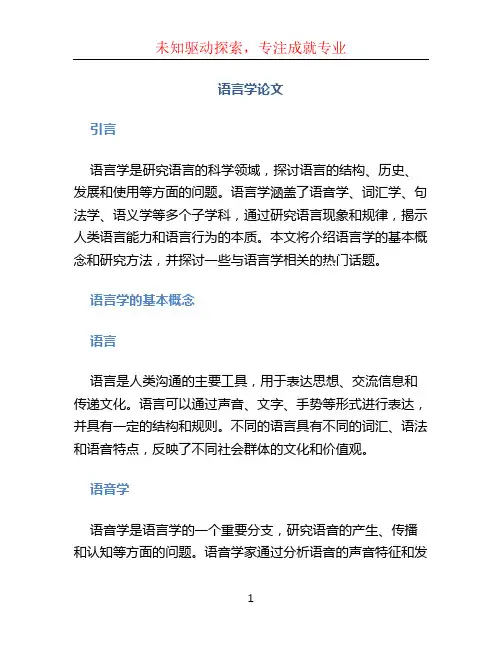
语言学论文引言语言学是研究语言的科学领域,探讨语言的结构、历史、发展和使用等方面的问题。
语言学涵盖了语音学、词汇学、句法学、语义学等多个子学科,通过研究语言现象和规律,揭示人类语言能力和语言行为的本质。
本文将介绍语言学的基本概念和研究方法,并探讨一些与语言学相关的热门话题。
语言学的基本概念语言语言是人类沟通的主要工具,用于表达思想、交流信息和传递文化。
语言可以通过声音、文字、手势等形式进行表达,并具有一定的结构和规则。
不同的语言具有不同的词汇、语法和语音特点,反映了不同社会群体的文化和价值观。
语音学语音学是语言学的一个重要分支,研究语音的产生、传播和认知等方面的问题。
语音学家通过分析语音的声音特征和发音方式,揭示语音的音位系统和音韵规律。
语音学对于理解语言的音素、音韵和音系等基本要素具有重要意义。
词汇学词汇学是研究词汇的学科,包括词汇的形态、词义、构词法和词汇变化等方面的内容。
词汇是语言的基本单位,通过词汇的组合和变化,人们可以构建不同的表达方式和意义。
词汇学的研究对于理解语言的语义结构和表达方式具有重要参考价值。
句法学句法学是研究句子的结构和语法规则的学科,包括句子成分、句子类型和句法关系等方面的内容。
句法学家通过分析句子的组织和成分之间的关系,揭示语言的语法结构和句法规则。
句法学的研究对于理解语言的句法结构和语法变化具有重要意义。
语义学语义学是研究语言的意义和人类思维的学科,涉及词义、句义和篇章意义等方面的内容。
语义学家通过分析词汇和句子的意义,探讨语言表达的逻辑关系和语义关联。
语义学对于理解语言的意义和语篇逻辑具有重要参考价值。
语言学的研究方法语言学的研究方法主要包括田野调查、统计分析和实验研究等。
以下将简要介绍这些研究方法:田野调查田野调查是语言学研究中常用的一种方法,通过对自然环境和语言使用情况的观察和记录,获取真实的语言数据。
研究人员可能会采访当地的居民,记录他们的口头语言和方言等。
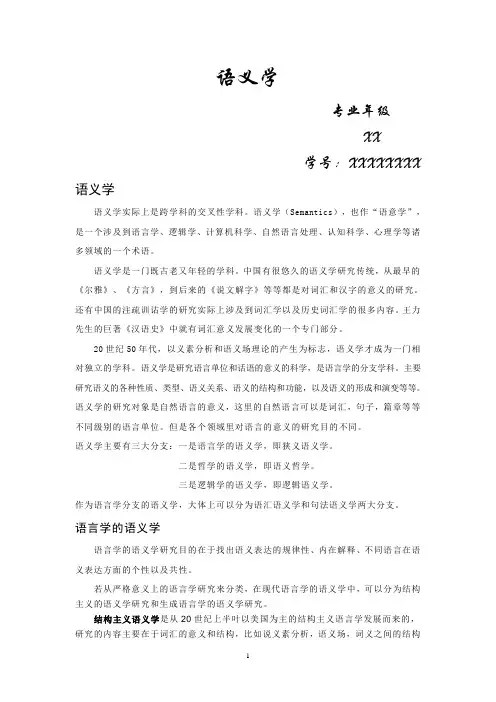
语义学专业年级XX学号:XXXXXXXX 语义学语义学实际上是跨学科的交叉性学科。
语义学(Semantics),也作“语意学”,是一个涉及到语言学、逻辑学、计算机科学、自然语言处理、认知科学、心理学等诸多领域的一个术语。
语义学是一门既古老又年轻的学科。
中国有很悠久的语义学研究传统,从最早的《尔雅》、《方言》,到后来的《说文解字》等等都是对词汇和汉字的意义的研究。
还有中国的注疏训诂学的研究实际上涉及到词汇学以及历史词汇学的很多内容。
王力先生的巨著《汉语史》中就有词汇意义发展变化的一个专门部分。
20世纪50年代,以义素分析和语义场理论的产生为标志,语义学才成为一门相对独立的学科。
语义学是研究语言单位和话语的意义的科学,是语言学的分支学科。
主要研究语义的各种性质、类型、语义关系、语义的结构和功能,以及语义的形成和演变等等。
语义学的研究对象是自然语言的意义,这里的自然语言可以是词汇,句子,篇章等等不同级别的语言单位。
但是各个领域里对语言的意义的研究目的不同。
语义学主要有三大分支:一是语言学的语义学,即狭义语义学。
二是哲学的语义学,即语义哲学。
三是逻辑学的语义学,即逻辑语义学。
作为语言学分支的语义学,大体上可以分为语汇语义学和句法语义学两大分支。
语言学的语义学语言学的语义学研究目的在于找出语义表达的规律性、内在解释、不同语言在语义表达方面的个性以及共性。
若从严格意义上的语言学研究来分类,在现代语言学的语义学中,可以分为结构主义的语义学研究和生成语言学的语义学研究。
结构主义语义学是从20世纪上半叶以美国为主的结构主义语言学发展而来的,研究的内容主要在于词汇的意义和结构,比如说义素分析,语义场,词义之间的结构关系等等。
这样的语义学研究也可以称为词汇语义学,词和词之间的各种关系是词汇语义学研究的一个方面,例如同义词、反义词,同音词等,找出词语之间的细微差别。
生成语义学是20世纪六七十年代流行于生成语言学内部的一个语义学分支,是介于早期的结构主义语言学和后来的形式语义学之间的一个理论阵营。
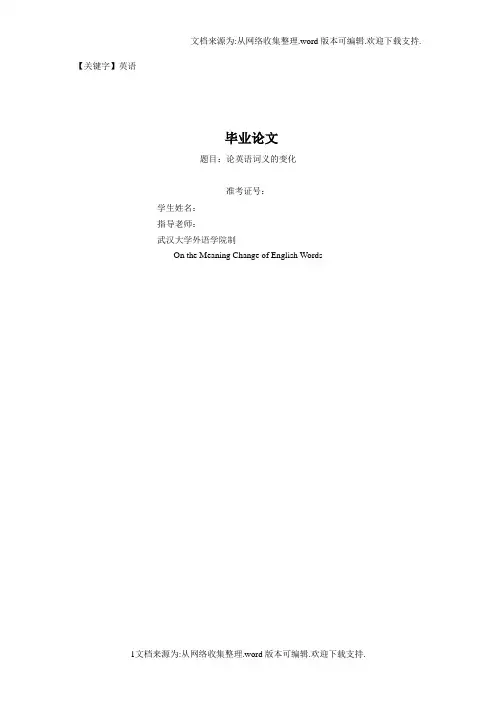
文档来源为:从网络收集整理.word版本可编辑.欢迎下载支持. 【关键字】英语毕业论文题目:论英语词义的变化准考证号:学生姓名:指导老师:武汉大学外语学院制On the Meaning Change of English Words文档来源为:从网络收集整理.word版本可编辑.欢迎下载支持.论文摘要语义学是关于意义的学问,它旨在研究语言单位,特别是单词和句子的意义。
词是语言中具有意义的,最小的能够独立运用的单位,所以关于词的意义(即词汇语义学)在语言学中占用重要的位置。
单词一直处在不断的变化过程当中,形式上的或是内容上的,常常是后者发生变化。
正像Quirk在1963年指出的那样,“…几乎我们现在使用的每一个词与其在一个世纪以前的意义稍有不同,而一个世纪以前的单词又和它在一个世纪之前的意义稍有差别” 。
广泛的讲,意义的变化指的是现行词义的变化,或是对现行词语添加新的义项。
这种变化随着时间的流逝而产生。
本论文探究了英语词义变化的方式、类型及原因。
希望本论文可以帮助英语专业的学生更好地学习英语词义。
关键词:词义; 变化; 方式; 类型; 原因文档来源为:从网络收集整理.word版本可编辑.欢迎下载支持.AbstractThe subject concerning the study of meaning is called semantics, which targets at the study of the meanings of linguistics units, such as words and sentences. A word is the minimum free form with certain meaning, thus the study of word meaning (lexical semantics) occupies an important position in linguistics study. Word has been constantly undergoing the process of changes,either in forms or in meanings, with the latter being more frequent. Just as Quirk said in 1963, “… almost every word we use today has a different meaning from the one it had a century ago, and a century ago it had a slight different meaning from the one it had a century bef ore that”. Broadly speaking, meaning change refers to the alternation of the meaning of existing words, as well as the addition of new meaning to established words. This change occurs along with time. This thesis explores the approaches, modes, causes of word meaning change. Hopefully, it may help us English majors study English word meaning better.Keywords: meaning;change;approach; mode; cause文档来源为:从网络收集整理.word版本可编辑.欢迎下载支持.ContentsI. Introduction (1)II. Approaches to meaning change of English words (2)2.1 extension approach (2)2.2 figurative approach (3)2.3 merger approach (3)III. Modes of meaning change of English words (4)3.1generalization (5)3.2 specialization (6)3.3 elevation (7)3.4 degradation (7)IV. Causes of meaning change of English words (8)4.1 extra –linguistics factors (8)4.2 linguistics factors (10)V. Conclusion (11)Bibliography (12)On the Meaning Change of English WordsI. IntroductionAs a branch of semantic study, the lexical semantics has been long regarded as the focal point. And the question as to what is the meaning of word becomes the first inquiry for language leaners. The objective matters, which exclude human mind, including all the living creatures, unanimated objects, events and their behavior, state and characteristics, etc. are reflected, thus sensation, perception, representation are produced first. Human mind then will generate the abstract preliminary products into concepts. Then man fixes the concepts in the vehicle of language, enabling us human beings to exchange our thoughts through these signs with certain meaning individually. Thus, words come into being. In other words, the meaning of words is endowed by men. As British linguist Eric Partridge once pointed out, “words have no meanings, p eople have meaning for them”. This process is generally agreed upon by all linguists. However, different people may hold different opinions on the sub-structure of word meaning.One difficulty in the study of meaning is that the word “meaning” itself has different meanings. In their book The meaning of meaning written in 1923, C.K Odgen and I.A Richards presented “a representative list of the main definition which reputable students of meaning have favored” (Odgen & Richards, 2003: 186). There are 16 majo r categories of them, with sub-categories totaling up to 22.The edifice of any language could be observed as a grand project composed of three elements: sound, lexicon, and grammar, among which sound is the physical shell of a language; lexicon serves as the “brick” and “concrete”; while grammar functions as the ways and principles by which linguistic elements are organized and oprate. So word meaning above all can be divided into two big categories: grammatical meaning and lexical meaning.Grammatical meaning corresponding with grammar signifies the grammatical aspect of a word. For example, “girl” is a single form, while “girls” represents the plural form in meaning.Lexical meaning, on the other hand, is the study of word meaning at its content level. For example, in the group of words “go, goes, gone, went, going”, each word has different grammatical meaning obviously, but their lexical meaning is the same, namely “to move or travel from one place to another” (Longman Dictionary of Contemporary English, 1998:746). Foreign linguists have different classifications on word meaning. Geoffrey Leech, a world famous Britishlinguist, categorizes seven types of meaning, as follows: conceptual meaning, connotative meaning, social meaning, affective meaning, reflected meaning, collocative meaning, thematic meaning, with conceptual meaning being the center of word meaning. And connotative meaning, social meaning, affective meaning, reflected meaning, and collocative meaning and thematic meaning can be brought together under the heading associative meaning(Leech.,1981).In the following sections, we are going to explore the approaches to meaning change, the modes of meaning change and the causes accounting for the meaning change. And with some basic knowledge of word meaning change in the thesis, it may cast light on how to gasp word meaning and help us English majors study English language better.II. Approaches to meaning change of English wordsThe change of word meaning refers to the process in which the existing word has some changes either in number of its meaning items or its content in its application or development. In this section we will take a glimpse at the trace of changes in word meaning. There are mainly three types as follows:2.1 Extension approachExtension refers to a way a word derived from a new through certain connections based on its original meaning, or its existing meaning items. For example, the word “hoe”(noun)meant “ a garden tool with a handle and a blade ,used for breaking up soil and re moving weds” and then a related meaning was produced , “to break up soil, remove plants, etc, with a hoe”, such as in the phrase “ to hoe a flowers”(Oxford Advanced Learner’ s English-Chinese Dictionary, 1997: 838), so “hoe” here is used as a verb. Howev er, we can easily see the close connection in meaning between the noun “hoe” and the verb “hoe”. Some words can create new meaning through extending or narrowing the scope of reference, which is also very common. For example, the word “journal” originally meant “a written record that you make of the things that happen to you each day (diary) (Oxford Advanced Learner’s English-Chinese Dictionary, 1997: 775). Let us look at another example, the word “wedge” (noun) originally meant “a piece of wood, robber, me tal, etc, with one thick end and a thin pointed end that you use to keep a door open, to keep two things apart, or to split wood or rock”, then its verbal meaning came into being, namely “ to put or squeeze something tightly into a narrow space, so that it can not move easily”(ibid).2.2 Figurative approachWhether the scope of reference extends or narrows, the type of object a word denotes has not changed. However, when a word has changed its literal meaning to its figurative meaning, the type of object is utterly different, and then semantic shift has occurred in word meaning. This is also a very important style of meaning changes.Abundant examples can serve as the illustrations of the figurative approach. For example, the word “burden” originally meant“a heavy load that is difficult to carry” and then people tended to use it for referring to “ a duty ,responsibility ,etc, that causes worry, difficulty or hard work”, for example, in the sentence “The main burden of caring for old people falls on the state”. This abstract sense of “burden” is very vivid and concise in the effect of expression, which will certainly leave a deep impression on the listener’s mind.2.3 Merger approachThis way of change in word meaning refers to another way of change in word meaning, reflecting the relationship between two words under certain circumstances. When one word’s scope of reference expands into that of another related word, meaning may then be annexed, making the latter one lose its status of independence. Comparatively speaking, this approach is less in frequency in word meaning change than the previous two approaches, which however should not be ignored by us English learners. In the study of antonyms, we come to know the concept of “gradable antonyms” first, the co mmonest type of antonyms. That is, the members of a pair differ in terms of degree. The denial of one is not necessarily the assertion of the other, and there is no absolute criterion of judgments by which we may say something is good or bad, long or short, big or small. Usually, the term of the higher degree serves as the “cover term”. For example, we ask somebody “how old are you?” and the person asked may not be old in any sense. He may be as young as twenty or three. The word “old” is used here to cover both old and young. The sentence above means the same as “what is your age?”. Technically, the “cover term” is called “unmarked”, i.e. usual; and the covered “marked”, or unusual. That means, in general, it is the “cover term” that is more often used. If the covered is used, then it suggests that is something odd, unusual here. The speaker may already know that something or somebody is young, small, near, and he wants to know the extent in greater detail. This characteristic is also reflected in the corresponding nouns, such as length, height, width, and depth.Because of the differences, a lot of word meanings are different. For example, in CambridgeInternational Dictionary of English, the word ‘individual’ is defined as ‘the idea that freedom of thought and action for each person is the most important quality of a society, rather than shared effort and responsibility’. It is positive. However, in The English-Chinese Dictionary, there is a sentence ‘These poets were individualists, wanting to explore their own thoughts and feelings, not content with the general truth’. Obviously, the meaning of ‘individualists’ is negative.III. Modes of meaning change of English wordsGenerally speaking, the development and change of word meaning is ever-increasing in number of meaning items almost in every language system, due to social development and word meaning development itself. However it becomes complicated as each individual word is concerned. For some, the number of meaning item may increase, and for others, just the reverse. And some words’ meaning may disappear, or reduce to morphemic meaning, etc.3.1 GeneralizationThe generalization of meaning is a process by which a word originally having a specialized meaning has now extended to cover a broader and often less definite concept.A large proportion of polysemic words of modern English have their meaning extended sometime in the course of development. Let us refer to some example as illustrations. The word “manuscript” today means “an author’s writing whether by hand or typed with a type writer or a word-procession”. But its old meaning referred to “handwriting”(written by hand)only. The word “fabulous” originally meant “resembling a fable” or “based on a fable”, but then it meant “incredible” or “marvelous”, since as we all knew that something incredible or marvelous often only existsd in fables, not in reality. Another example is the word “barn”. It meant “a place for stor ing only barley”, but now its meaning extends to “storeroom”. More examples are available here to cast light on the generalization of meaning.Word Old meaning Extended meaningbutcher one who kills goats one who kills animalsbonfire fire on bones a fire in the open madeby burning anything What is more, “thing” is often associated with “any”, “some”, and “no”, namely “anything”, “something”, and “nothing” respec tively. The frequency of these three words is high in both written and spoken form, the latter one especially. I have oncecounted and amazed at the high frequency one tend to employ “something” when he or she tries to introduce or explain a certain object, event, idea, etc. Other words like business, concern, matter, article, and circumstance have undergone similar process of meaning generalization.3.2 SpecializationSpecialization of language is a process by which a word which is used to have a more general sense becomes restricted in its application and conveys a special concept in present-day English. A typical example is the word “ deer”, which was used to refer to all kinds of animals, for example in Shakespeare’s sentence “ rats a nd mice and such small dear”; i n British English, “corn” was once used as “grain”, but in present-day American English, it only refers to “maize”; w hen “garage” was first borrowed from French, it meant more other than “any safe place”, but at present “garage” narrows down to “ a place for storing cars”—a shelter for cars only. Here are more examples:Word Old meaning Specialized meaning girl young person of either sex female young person wife woman married womanaccident event unfortunate eventChange of meaning is frequently brought about by two tendencies in a language system: toward ellipsis and toward analogy. Ellipse as a cause of semantic change often occurs in habitual collocations, such as adj + n. or attributive + n, in which the noun is often deleted and only the first element(the attributive) is left, but retaining the sense of the whole phrase.For example, “a gener al” comes f ro m “ a general officer”, “bugle” from “ bugle horn”, “gold” from “gold me t al”, “uniform” f ro m “uniform dress”, “ transistor” f rom “transistor radio”, “daily” f ro m “ daily newspaper”, etc.Another case of specialization occurs when a common noun changes into a proper one, and its meaning specializes correspondingly. For example, the City refers to “London business center”; The Peninsula refers to “Iberian Peninsula” only; and the word “Prophet” refers to Muhammad, who founded the religion of Islam.3.3 ElevationElevation of meaning is a process by which words rise from humble beginning to a position of importance. In other words, some words in their early history signified something low or humble, but as time goes by, the meaning changed to designate something agreeable or pleasant. A typical case in point is the word “nice”. It originally meant “ignorant”, then “foolish”, but later it was dramatically eleva ted to“delightful, pleasant”;Marshal(high—ranking army officer) and Constable(police man) were both once referred to “keeper of horses”. More relevant examples are also provided here:Word Old meaning Elevated meaningknight servant rank below baronetangel messenger messenger of Godminister servant head of ministryNobody nowadays is reluctant to be described as “shrewd” perhaps, or “nimble”. However, for some time these two words are rather derogatory in meaning.A shrewd man was once often associated with “evil” or “wickedness”, while a nimble man is considered as someone taking something without certain permission; and the word “success”, a desirabl e destination for anyone to reach, was once only a simply neutral “result”.3.4 DegradationContrary to elevation, degradation of word meaning is a process whereby words of good origin or affective neutrality fall into ill reputation or come to be used in a derogatory sense. An interesting fact is that many addresses for common people have taken on derogatory color. For example, “churl”which used to refer to “peasant” or “free man” has changed into “uncultivated or mean person”;“wench” once referred to “country girl”, but now it has degraded into “prostitute”;“villain”once referring to “person who worked in a villa”has now changed into “evil or wi cked person or scoundrel”. The following words have also undergone similar changes: Word Old meaning Degraded meaningknave boy dishonest personlust pleasure sexual desirelewd ignorant lecherousAs statistics shows that it is much more common for word meaning to change in denotation from neutral to pejorative than it is for them to go to the other way.The above-mentioned four types are the main types of word meaning changes, excluding transference, comparatively taking a small percentage in word meaning change, which thus is not within the framework of the present thesis discussion. IV. Causes of meaning change of English wordsWith the ever-changing human society, language as the vehicle of communication is also in the process of change and development. Both linguistic and extra-linguistic factors are exerting influence on word meaning changes. We can find out certain rules beneath the surface of meaning variations, which will deeper our understanding of word meaning.4.1Extra-linguistic factorsMeaning has always been a centre topic in human scholarship, though the term “semantics” has only a history of a little over a hundred years, let alone lexical semantics. There were discussions of meaning in the works of the Greek philosopher Plato as early as in the fifth century before Christ. In China, Lao Zi had discussed similar question even earlier. The fact that over the years numerous dictionaries have been produced with a view to explaining the meaning of words also bears witness to its long tradition. The research on word meaning has been drawing attention from linguists, philosophers and anthropologists, psychologists, and so on. This also exemplifies the fact that many extra-linguistic factors contribute to the change of word meaning.1.Historical reason. It often happens that a word is retained for a name though the meaning has changed because the referent has changed. The famous linguist Ullman once said “language should be more conservative than either material or spiritual civilization. Objects, styles, points of view and scientific concept have all changed in the course of time. But in many cases, the names were retained which helpto ensure that the tradition and continuity of a language.”(Zhou, 2007: 198). Take “pen” as a example. “Pen” in the beginning refer red to “feather”, since people in the West used feather to make a “pen”. Nowadays, we have already said farewell to the age of using a feather pen, and we prefer to use ball pen or fountain pen. But we still stick to employ the name “pen”; “car”once referred to “two-wheel cart drawn by horses and used in war”. With the development of modern automobile technology, “car” has changed to refer to “automobile”; similarly, “computer” originally mean t “person who computes”, but now it is another case. When we talk about computer, the first image jumping into our minds is definitely “a electric machine” instead of“a person”.Increased scientific knowledge and discovery are also important factors that account for the change of word meaning. For example, people believed in ancient times that the sun was one of the seven planets revolving the earth. And this meaning could still be seen in the sentence “The sun rises and sets”, although people nowadays have alread y accepted Copernicus’ theory that “sun is a star around which the earth and other planets revolve”.2.Class reason. Language is a mirror perfectly, reflecting everything in the human society, which records speeches and attitudes of people from all walks of life. And various social variants have then come into being. The attitudes of different classes have also made inroads into lexical meaning in the case of elevation or degradation. The so-called “King’s English”is a typical example. There are a considerable number of words of different professions, which often have derogatory meaning. Since in the eyes of the aristocrats, the working people are ignorant, stupid, and rude in behavior. For example, words “churl, hussy, wench, and villain” have all degrade d from neutral sense into “ill-mannered or bad people”. What is more, words like “democracy, revolution, liberation, human rights and communism” have quite different meanings to different people or in different society.3. Psychological reason. The associated transfers of meaning and euphemistic use of words are often due to psychological factors. For example, in American Civil War, Copperhead (a kind of poisonous snake) was used to refer to someone whosupported the Southerners secretly. As to the latter usage above (euphemistic), many humble and despised occupations often taking more appealing names is all due to psychological reasons. Americans are especially fond of using euphemistic expressions. For example, “garbage collector”is called “sanitation engineer”in America and “disposal” in Britain; “g ardener” changes into “landscape architect”; and “servant” changes into “domestic engineer”. As statistics shows, the so-called “engineer” is more than two hundred among respectful addresses in English.Besides, religious influence is another kind of psychological reason. As Cardinal Trench once said, “ange l”, “martyr” and “paradise” have their meanings elevated due to the influence of the Christianity.4.2 Linguistic factorsThere are exterior reasons for the change of word meaning, and also the interior reason, i.e. the development of language itself. Here as the follows.Firstly, a phrase is often be shortened to a word without losing the original entire meaning. For example, “gold” is used for “gold medal”, “gas” for “ coal gas”, “bulb” for “light bulb”, and “private” for “private soldier”. Under these circumstances, whatever is left, a noun or an adjective, is used as a noun to be the equivalent of the original expression.Secondly, the influx of borrowing words in great number has also resulted in the change of word meaning. For example, “deer” once referred to all kinds of animals. With the coming of Latin word “animal” and the French word “beast”, these three words were forced to re-identify their status as they all have the same denotation. As a result, “animal” kept its original sense, and “deer” shortened its meaning reference scope, while “beast” changed its semantic color into derogatory.At last, analogy can also bring about meaning changes. For example, the word “fortuitous” once meant “happening by chance, accidental”. But later it extend ed to have the meaning of “fortunate”. Is there a logical explanation for that? Perhaps, this is a process of the demonstration of “analogy”. “Fru ition” originally meant “a pleasure we obtain from using or possessing something” and ha d no relationship in meaning with “fruit”. However, one of its meaning items “the bearing of fruit” isprobably the result of association based on “fruit”.Besides, cultural psychology is the study of the way cultural traditions and social practices regulate, express, and transform the human psyche, resulting less in psychic unity for humankind than in ethnic divergences in mind, self, and emotion. When one learns a language, it is important to learn its cultural psychology. For example, when Chinese people observe a thing, they will start from the whole, but the westerners will start from the part.V. ConclusionThis thesis explores the approaches, modes, causes of word meaning change. Semantic change plays a very important role in widening the vocabulary of a language. Since language is symbolic, each word serves as a symbol in relation to a specific meaning. In this sense, we need infinite number of word or symbols to code the physical entities and our experiences, which will be ultimately proved impossible and obstruct the smooth operation of communication. So an old form is given a new concept, thus the meaning of a form is multiplied.The approaches in which word meaning changes represent the main types of changes and indicate both linguistic and extra-linguistic causes. After acquiring some basic knowledge of word meaning changes, one may could not help asking such a question “What measures can be adopted in daily study?”. Hopefully this thesis could cast new light on the study of English word meaning for us English majors and help us lay a solid foundation for the exploration of the wonders of the English language.BibliographyCambridge International Dictionary of English [D], Shanghai: ShanghaiForeign Language Education Press, 2008Longman Dictionary of Contemporary English [Z], Beijing: The CommercialPress, 1998Leech, G, A, Semantics: the study of meaning, 2nd edition, Harmondsworth:Penguin, 1981Oxford Advanced Learner’s English-Chinese Dictionary[Z]. Beijing: TheCommercial Press, Oxford University Press, 1997Odgen,C,K,& Richards,I,A, The meaning of meaning, London: Routledge &Keganpaul, 2003The English-Chinese Dictionary[D], Shanghai: Shanghai Foreign Language Education Press, 2005Zhou, Ruiying, A study of teaching English word meaning[M], Changsha:Hunan Normal University, 2007池昌海, <<现代语言学导论>>, 浙江: 浙江大学出版社,2004胡壮麟主编, <<语言学教程>>(修订版), 北京: 北京大学出版社,2001胡壮麟、姜望琪主编, <<语言学高级教程>>, 北京: 北京大学出版社,2004 李赋宁, <<英语史>>, 北京: 商务印书馆,2008汪榕培、卢晓娟, <<英语词汇学教程>>, 上海: 上海外语教育出版社,2007 此文档是由网络收集并进行重新排版整理.word可编辑版本!。
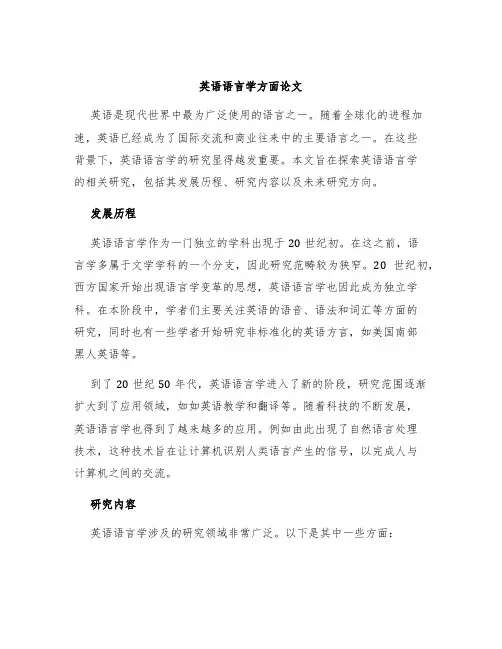
英语语言学方面论文英语是现代世界中最为广泛使用的语言之一。
随着全球化的进程加速,英语已经成为了国际交流和商业往来中的主要语言之一。
在这些背景下,英语语言学的研究显得越发重要。
本文旨在探索英语语言学的相关研究,包括其发展历程、研究内容以及未来研究方向。
发展历程英语语言学作为一门独立的学科出现于20世纪初。
在这之前,语言学多属于文学学科的一个分支,因此研究范畴较为狭窄。
20世纪初,西方国家开始出现语言学变革的思想,英语语言学也因此成为独立学科。
在本阶段中,学者们主要关注英语的语音、语法和词汇等方面的研究,同时也有一些学者开始研究非标准化的英语方言,如美国南部黑人英语等。
到了20世纪50年代,英语语言学进入了新的阶段,研究范围逐渐扩大到了应用领域,如如英语教学和翻译等。
随着科技的不断发展,英语语言学也得到了越来越多的应用。
例如由此出现了自然语言处理技术,这种技术旨在让计算机识别人类语言产生的信号,以完成人与计算机之间的交流。
研究内容英语语言学涉及的研究领域非常广泛。
以下是其中一些方面:1. 语音学语音学研究语音的产生、使用和描述。
这个领域的研究可以解释语言中不同音素之间细微差别的生理和物理机制。
语音学从英语学习的角度探讨点便是如何发音,音素之间的变异以及其他与英语发音有关的问题。
2. 语法学语法学是英语语言学的基础,用于研究言语产生的规则和机制,以及词汇和结构在句子中的使用。
语法学可以深入研究单词的结构以及其在句子中的功能,研究文化及其逻辑结构的规则,以及句子结构的研究等等。
3. 语义学语义学是研究语言意义的学科领域。
这个领域的研究可以解释和分析个别语言单词的意义和该单词在上下文中的实际含义。
语义学深入到许多不同的领域,包括语言哲学、语言学和社会学。
4. 语用学语用学是研究语言在特定上下文中实际使用的学科领域。
语用学从语言学和社会学的角度来研究语言使用,研究语言在上下文中不同的意义,以及语言与文化、行为以及认知之间的联系。
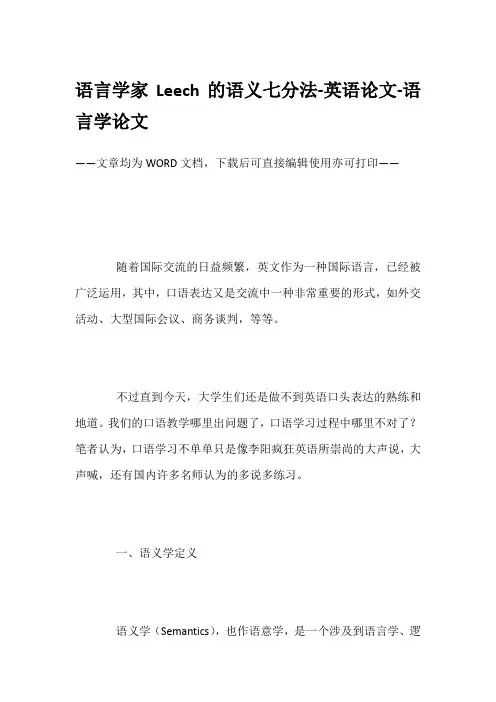
语言学家Leech的语义七分法-英语论文-语言学论文——文章均为WORD文档,下载后可直接编辑使用亦可打印——随着国际交流的日益频繁,英文作为一种国际语言,已经被广泛运用,其中,口语表达又是交流中一种非常重要的形式,如外交活动、大型国际会议、商务谈判,等等。
不过直到今天,大学生们还是做不到英语口头表达的熟练和地道。
我们的口语教学哪里出问题了,口语学习过程中哪里不对了?笔者认为,口语学习不单单只是像李阳疯狂英语所崇尚的大声说,大声喊,还有国内许多名师认为的多说多练习。
一、语义学定义语义学(Semantics),也作语意学,是一个涉及到语言学、逻辑学、计算机科学、自然语言处理、认知科学、心理学等诸多领域的一个学科。
虽然各个学科之间对语义学的研究有一定的共同性,但是具体的研究方法和内容大相径庭。
语义学的研究对象是自然语言的意义,这里的自然语言可以是词,短语(词组),句子,篇章等等不同级别的语言单位。
二、Leech 的语义七分法其中语言学家Leech 将语义分成了七种,分别为概念意义、伴随意义、社会意义、情感意义、联想意义、搭配以及主题意义。
(一)概念意义概念义是语言系统里最核心的意义,语言的其他意义都必须以此为参照。
在词汇输入时,对其概念意义片面的、局限的理解,才造成如此大的误差和错误。
那么也就注定很难讲出地道的、正确的英文。
因此,作为英语学习者查阅英英词典,彻底了解词语的语义,输入正确的英文信息,才能在运用时候,表达出正确的概念和语义,才能够进行顺畅的、良好的交流,从而达到学习语言的目标。
(二)伴随意义伴随意义或者内涵意义,又叫伴随意义:一个词语的内涵意义是通过该词的所指表达出的交际价值,即建立在概念意义之上的一种附加的、非标准性的意义,如:附着在词汇男人之上的伴随义是豪爽、健壮、义气,附着在女人之上的伴随义是温柔、体贴、。
也比如说owl 对西方人来说它伴随的意义是聪明与智慧,对我们来说却并非如此,它代表着、、神秘。
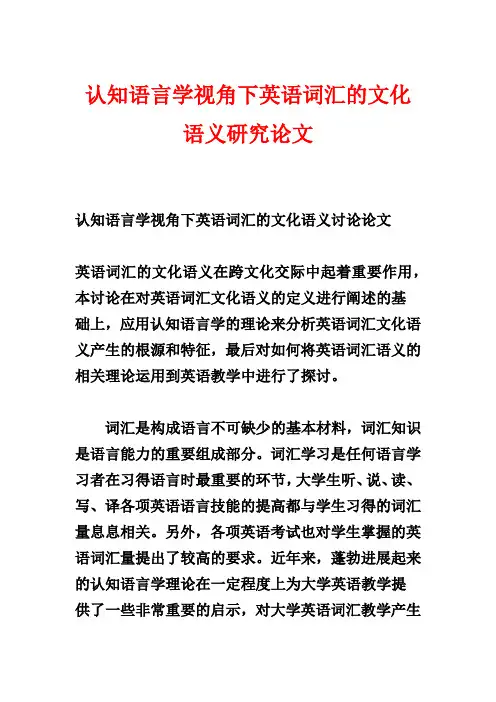
认知语言学视角下英语词汇的文化语义研究论文认知语言学视角下英语词汇的文化语义讨论论文英语词汇的文化语义在跨文化交际中起着重要作用,本讨论在对英语词汇文化语义的定义进行阐述的基础上,应用认知语言学的理论来分析英语词汇文化语义产生的根源和特征,最后对如何将英语词汇语义的相关理论运用到英语教学中进行了探讨。
词汇是构成语言不可缺少的基本材料,词汇知识是语言能力的重要组成部分。
词汇学习是任何语言学习者在习得语言时最重要的环节,大学生听、说、读、写、译各项英语语言技能的提高都与学生习得的词汇量息息相关。
另外,各项英语考试也对学生掌握的英语词汇量提出了较高的要求。
近年来,蓬勃进展起来的认知语言学理论在一定程度上为大学英语教学提供了一些非常重要的启示,对大学英语词汇教学产生了巨大影响。
一、英语词汇的文化语义英语词汇的文化语义内涵丰富,只有充分了解英语词汇的文化内涵,才能准确完整理解英语词义。
近年来,很多国内外学者对英语词汇的文化语义内涵从不同方面进行了讨论。
认知语言学以认知科学为依托,近年来获得了快速进展,讨论成果在教学讨论和实践领域获得了广泛的应用。
认知语言学认为,人们对客观世界的体验形成了认知范畴的知识,将知识概念存储在大脑中,就形成了语言中的词汇。
20世纪50年代,维特根斯坦在著名的家族相似性原理中指出,词汇具有多种意义,其中一个是中心意义(即原型),其他意义依靠家族相似性与中心意义组成一个范畴。
人们掌握了中心意义后,即可以依据家族相似性的原则类推到其他实例中,从而可了解范畴的全部所指。
国内从认知语言学的角度对英语词汇的讨论与国外相比要晚一些。
从20xx年开始,才有相关的讨论成果出现。
梁晓波重点论述了认知语言学所关注的基本范畴词汇、词语语义理据、词语多义之间深层联系、词语隐喻义和认知语义学理论等方面对当前大学英语词汇教学的指导作用。
20xx年,朱亚夫结合英语和汉语的实例,对英国语言学家利奇提出的词语意义的七种类型做了简要的评述,从宏观上提出英语词汇学习应结合词语的社会文化背景知识进行,注重词汇的文化语义内涵挖掘。
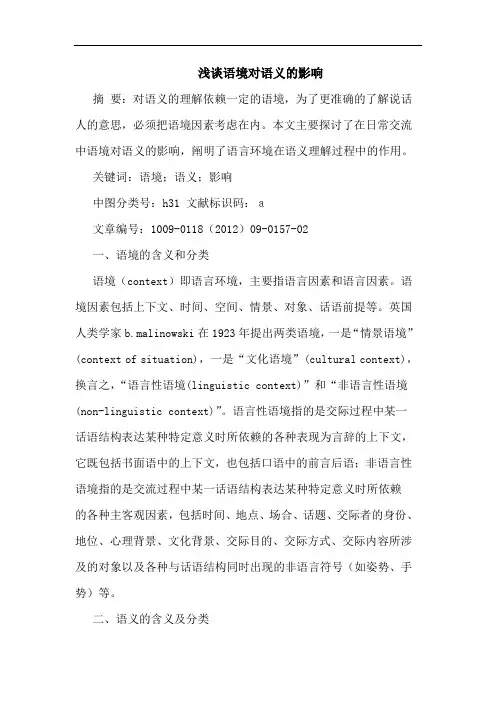
浅谈语境对语义的影响摘要:对语义的理解依赖一定的语境,为了更准确的了解说话人的意思,必须把语境因素考虑在内。
本文主要探讨了在日常交流中语境对语义的影响,阐明了语言环境在语义理解过程中的作用。
关键词:语境;语义;影响中图分类号:h31 文献标识码:a文章编号:1009-0118(2012)09-0157-02一、语境的含义和分类语境(context)即语言环境,主要指语言因素和语言因素。
语境因素包括上下文、时间、空间、情景、对象、话语前提等。
英国人类学家b.malinowski在1923年提出两类语境,一是“情景语境”(context of situation),一是“文化语境”(cultural context),换言之,“语言性语境(linguistic context)”和“非语言性语境(non-linguistic context)”。
语言性语境指的是交际过程中某一话语结构表达某种特定意义时所依赖的各种表现为言辞的上下文,它既包括书面语中的上下文,也包括口语中的前言后语;非语言性语境指的是交流过程中某一话语结构表达某种特定意义时所依赖的各种主客观因素,包括时间、地点、场合、话题、交际者的身份、地位、心理背景、文化背景、交际目的、交际方式、交际内容所涉及的对象以及各种与话语结构同时出现的非语言符号(如姿势、手势)等。
二、语义的含义及分类词语由词形和语义构成,词形包括发音和拼写,语义是词形所代表的意义。
语义是词语本身含义和语境意义的结合。
语义并非单一形式的,而是一个包含几个部分的合成体,即我们常说的语义类别。
语义通常分为语义学中的语义和语用学上的语义两种。
语义学中的语义被看作是语言本身所固有的、不可改变的含义。
它主要由词汇、语法特征来决定,此外这种语义不受上下文语境的影响,因此我们也习惯把它叫做“静态意义”或者“表面意义”。
而语用学中的意义:与语义学中的意义是不一样的。
此意义除了包含语言本身以外的所有意义。
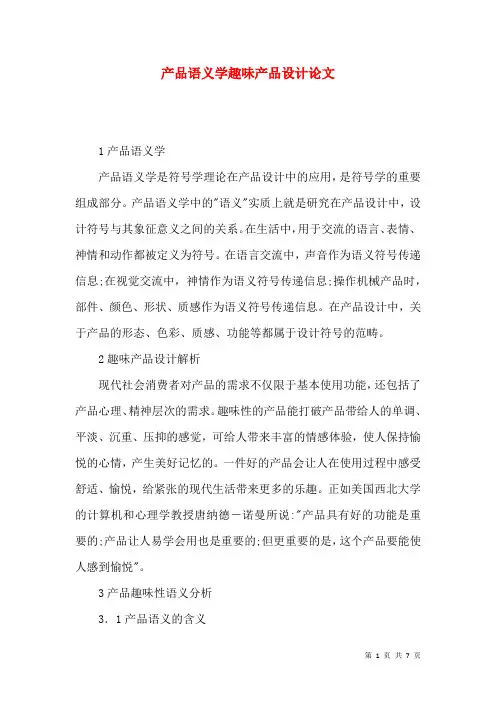
产品语义学趣味产品设计论文1产品语义学产品语义学是符号学理论在产品设计中的应用,是符号学的重要组成部分。
产品语义学中的"语义"实质上就是研究在产品设计中,设计符号与其象征意义之间的关系。
在生活中,用于交流的语言、表情、神情和动作都被定义为符号。
在语言交流中,声音作为语义符号传递信息;在视觉交流中,神情作为语义符号传递信息;操作机械产品时,部件、颜色、形状、质感作为语义符号传递信息。
在产品设计中,关于产品的形态、色彩、质感、功能等都属于设计符号的范畴。
2趣味产品设计解析现代社会消费者对产品的需求不仅限于基本使用功能,还包括了产品心理、精神层次的需求。
趣味性的产品能打破产品带给人的单调、平淡、沉重、压抑的感觉,可给人带来丰富的情感体验,使人保持愉悦的心情,产生美好记忆的。
一件好的产品会让人在使用过程中感受舒适、愉悦,给紧张的现代生活带来更多的乐趣。
正如美国西北大学的计算机和心理学教授唐纳德-诺曼所说:"产品具有好的功能是重要的;产品让人易学会用也是重要的;但更重要的是,这个产品要能使人感到愉悦"。
3产品趣味性语义分析3.1产品语义的含义产品语义强调的是人与物之间的一种交流,即通过产品的材料、形态、结构、色彩质感等视觉语言向使用者揭示或暗示产品的内部结构,使产品功能明确化,使人机界面单纯、易于理解。
产品语义分为外延性语意和内涵性语意。
外延性语意是更直接的语意表达,通过形态、构造特征等元素来表达使用目的、操作、功能等内容,使人能够通过产品的外形设计直观地明白产品的功能、用途和使用方法。
内涵性语意是一种感性的认知,通常是指产品中所包含的社会文化和个人联想(如意识形态、情感等)。
通过产品的造型形态喻示出使用者和使用环境,进而指示出使用者的社会地位、文化品位、价值观等象征价值。
内涵语义以外延语义为前提,产生于特定的场合和环境中,依据用户的主观因素而随时变动。
内涵语义比外延语义更多维,更开放、更深刻。
从语义学角度来探讨语言中的隐喻[摘要]隐喻(metaphor)是一个常见的文化现象。
表面上看隐喻只是一种润饰辞藻的修辞手法,然而其背后蕴含着人类几千年来积淀的智慧,反映出人类对世界、对自身的认知,也是人类改造世界的桥梁。
因此隐喻不仅仅是一个语言学问题,还涉及到哲学、美学、心理学等领域,古往今来也有无数大家对隐喻进行研究。
本文作者凭借其所掌握的基础语言学知识,试图初步地从语义学(Semantics)角度来探讨隐喻的结构、本质、意义和运用。
[关键字]隐喻语义学字面意义/比喻意义本质认知一.引言在大学以前的初等教育中,“比喻”常被强调,然而“隐喻”却极少提到。
使我对隐喻这一语言现象产生兴趣的是熊学亮教授的著作《语言学新解》上的一个例子:You are wasting my time.The gadget will save your hours.I don’t have the time to give you.How do you spend your time these days?以上的语句都是“时间是金钱”这种基础隐喻的变体,是用与“金钱”具体概念有关的东西来衬托出抽象概念“时间”的价值①。
在这些语句中,比如“waste”和“time”、“spend”和“time”都是我们平时习以为常但从未想过这也是一种隐喻的搭配,从中我看到了隐喻神奇的魔力并对它产生了强烈的好奇心。
Lakoff(1987)认为,“隐喻普遍地存在于我们的日常生活中,不但存在于语言中,而且存在于我们的思维和行动中。
我们赖以思维和行动的一般概念系统,从本质上讲是隐喻式的”。
因此我把这无处不在的隐喻作为我期末论文的主题,希望能初步地了解这朵语言学中的奇葩。
二.历史中的隐喻在西方,隐喻作为修辞学的一部分,其发展和修辞学的历史息息相关。
西方修辞学诞生于2000多年前古希腊。
当时希腊的民主形式得到一定的发展,在议会上进行政治辩论和在法庭上辩护法律辩论的需要促使人们去学习演讲、劝说、辩论的艺术,修辞学就此诞生。
浅析结构语义学对英语词汇教学的启示[摘要]:本文通过对结构语义学语义关系及其基本理论的概述,具体通过下义关系,反义关系及相对关系三种语义关系,探讨这一理论在英语词汇教学中的应用。
[关键词]:结构语义学语义关系词汇教学一、结构语义学(structural semantics)概述结构语义学是现代语义理论中很新颖的一个分支。
david crystal 所著的a dictionary of linguistics and phonetics对这一概念是这样解释的:“structural semantics is an influential contemporary position,which is still in its early stages of analyzing the sense relations that interconnect lexemes and sentences.”又如《语言与语言学词典》这样描述道:“结构语义学指的是这样一些语义(semantics)研究方法:它更关注词或词组之间的‘意义关系’,而不是那么注重研究‘概念’意义和‘所指’意义(meaning)。
”从这两种解释中,我们不难领悟到一个共同的东西,那就是“sense relations”,即“意义关系”。
这正是结构语义学对词的研究宗旨,也即是结构语义学的基本理论。
这种理论的基本论点是:某些词与另一些词之间是有联系的;这是一种“含蓄的”语义关系。
也就是说,这是一种在“词义”中的暗示(或包含)的联系。
二、结构语义学理论之运用于英语词汇教学结构语义学理论可以帮助学生加深对含蓄的语义关系的理解,从而提高语言的运用能力,有效地增强学生的英语交际能力。
下面,从三个方面谈一谈作者在运用这一理论进行英语词汇教学时的一些感受。
(一)下义关系下义关系是指上义词和下义词之间的关系,也叫语义内包(semantic inclusion),它指表示个别概念的词被内包在表示一般概念的词中。
关于“语义的灵活性与核心意义”研究的总结“语义的灵活性与核心意义”是Lawrence M. Schoen 于1988年发表在Journal of Psycholinguistic Research 上的一篇文章。
文章阐释了一个非常普遍且简单易懂的语义学原理,即上下文的变化与词汇的核心意义之间的关系。
每个词汇的语义都不是唯一的,而是灵活变化的,在特定语言环境下每个词汇都有它突出的核心意义,但不是唯一意义,这就是语义的灵活性。
上下文的变化会引起语义的变化,这是日常生活中最常见的语义学现象之一。
在这篇文章中,作者借由名词属性的显著率saliance rating来证明上下文变化在语义变化中起到的作用,证明了上下文的变化会引起名词特性的显著率的变化,而名词特性的显著率的变化证明了该名词核心意义的变化。
从而证明了上下文的变化通过语义的灵活性对词汇核心意义造成的变化和影响。
为了更好的证明观点,作者首先着重阐述了语义学相关领域的研究历史与研究现状。
得出语义学研究是一个偌大的网络,涉及到其他各个语言领域之间的联系。
当今的语义学研究着重于语义记忆的比较宏观的部分,例如一个单独词汇的意义是如何储存的;它是以何种形式存在;它的构成部分有哪些;以及它要遵循哪些语义规则等等。
而作者的研究目的是检验上下文在语义灵活性中是如何发挥作用的。
如果在实际生活中,上下文的变化导致了语言意义的变化,则容易得出词汇的属性显著率也会随着上下文的变化而受到影响。
为了证明这个,作者做了两个实验。
为了更好的阐释实验,作者先给出了几个概念。
每个名词都有它的很多属性。
有的属性比较常用,而有的属性是在特定情形下才会出现。
例如篮球,它的属性就有很多种,如球体,圆形,有弹性,是一种运动器具等等。
作者将名词的多种属性分为两类:主要属性和次要属性。
主要属性,即central property,是指这个名词最常用的属性,即最明显最常见的特征。
通常和上下文没有关系(context-independent),就算是没有上下文,也能看出名词的这一属性。
《语义学》何英玉 2005 上海外语教育出版社论文集1.现代语义学的特点与发展趋势束定芳《外语与外语教学》2000.7根据语义学近100年来的发展过程和特点,我们可以把语义学研究概括为四个阶段:(一)准备阶段约1885年至1880年(二)词源学阶段约1880年至1930年(三)结构主义语义学阶段约1930年至1962年(四)多元化阶段指20世纪70年代以后至今的阶段。
第四阶段,即现代语义学阶段,具有如下四个主要特点:多学科、跨学科、多维度和多层次。
其中多维度指人们从不同的角度对同一种语义现象进行阐述和人们从不同的角度来观察和描述语义现象,揭示原来不为人们所知晓的事实。
近年来新发展起来的认知语言学就是从语言与人类思维的相互作用方面来研究语言的很好的尝试。
现代语义学发展的主要领域与发展趋势(1)词汇语义学现代词汇语义学除了继续关注传统研究课题(其中传统词汇语义学实际上是一种词源学,研究的主要内容是意义的变化和变化的原因等等。
结构主义阶段的词汇语义学主要研究意义的分解,即义素分析和意义的结构关系,特别是意义的聚合关系,如同义关系、反义关系、语义场等和组合关系,如搭配、选择限制等)外,尤其重视词汇意义与外部世界的关系、词汇意义与认知、词汇与句法的对接等等。
词汇是集语音、句法和概念于一身的特殊的语言单位。
(2)句子语义学研究 a.形式语义学 b.言语行为理论 c.含义理论(3)话语意义研究2.语义学与词典编撰郑述谱《辞书研究》1987.5正如专家们指出的,一个词的使用范围越宽,那么它的含义也就越空。
3.语言理据探究严辰松《解放军外国语学院学报》2000.6英国语言学学者Stephen Ullmann 是最早对语言理据展开详细讨论的人。
它在《语义学》一书中提出词的理据性主要有三类:语言理据(拟声理据),形态理据,语义理据。
注:Ullmann, Stephen. Semantics: An Introduction fo the Science of Meaning [M]. Oxford: Basil Blackwell, 1962.词的语义理据通过将词的基本语义加以引申或转喻而产生。
关于语义学的文献综述摘要:本文旨在对语义学的相关研究进行综述。
通过对相关文献的综合分析,本文介绍了语义学的发展历程、主要研究内容以及当前的研究热点。
同时,讨论了语义学在自然语言处理、人工智能等领域的应用,并对未来的研究方向进行了展望。
一、引言语义学是研究自然语言中词语和句子的意义的学科,它关注语言的意义是如何被传达和理解的。
随着计算机技术和人工智能的发展,语义学在自然语言处理、机器翻译、信息检索等领域的应用越来越广泛。
二、语义学的发展历程(一)传统语义学传统语义学主要关注词汇和句子的字面意义,以及它们之间的关系。
(二)现代语义学随着数理逻辑和计算机科学的发展,现代语义学开始采用形式化的方法来描述语义。
三、语义学的主要研究内容(一)词汇语义学词汇语义学研究词语的意义及其与世界之间的关系。
(二)句子语义学句子语义学研究句子的意义及其与语境之间的关系。
(三)语用学语用学研究语言在实际交际中的使用及其与语境之间的关系。
四、语义学的应用领域(一)自然语言处理语义学在自然语言处理中扮演着重要的角色,如词法分析、句法分析、语义理解等。
(二)机器翻译语义学可以帮助机器翻译系统更好地理解源语言和目标语言之间的语义关系,从而提高翻译质量。
(三)信息检索语义学可以用于信息检索系统,帮助用户更好地理解搜索结果的含义。
五、当前研究热点(一)语义网语义网是一种基于语义技术的下一代互联网,它旨在通过对语义信息的表示和推理,实现智能化的信息处理和服务。
(二)语义推理语义推理是指根据已有的语义信息和知识,推导出新的语义结论的过程。
(三)多模态语义学多模态语义学是指研究多种模态(如文本、图像、音频等)之间的语义关系和语义推理的学科。
六、结论语义学作为一门研究语言意义的学科,在自然语言处理、人工智能等领域有着广泛的应用前景。
未来的研究将更加注重语义的多模态、跨领域和深度学习等方面,为实现更加智能化的语言处理和交互提供支持。
认知语义学视角下的词汇学习研究认知语言学聚焦心智发展与语言能力发展关系,综合认知科学最新成果,将个人思维过程和日常生活体验进行整合研究,认为个体语言与心理现象存在关联,语言反映出心理投射的各种形象,“人类只有通过头脑中的概念范畴(conceptual category)才能接触现实,语言中反映的现实结构是人类心智运作的产物”(萨伊德,吴一安:f42),因而语言研究更多的关注点在于主观心理特质与思维特征,从而挖掘语言生成与发展规律,更好解释人类各种语言现象。
在外语学习中,词汇积累是前提,也是基础,如何扩充外语词汇,提升学习质量,是摆在许多学习者面前的当务之急。
认知语言学将语言表达视作心理过程,强调了人的主观能动性对语言形成发展的影响,形成了注意观和突显观。
(赵艳芳:p9)以认知语言学背景下的认知语义学为指导,探索词汇意义存在和生成根源,进而探索词汇构建规律。
“认知语义学主要研究词和概念结构之间的关系,它和传统的真值语义学(truth conditional semantics)表现出对意义的不同理解。
……认知语义学认为意义不直接反映外部世界,而是反映人对外部世界的认识。
语言不是大脑中一个独立的部分,而是认知结构的一个组成部分。
”(泰勒,蓝纯:f25)。
以认知语言学背景下的认知语义学为指导,探索词汇意义存在和生成根源,进而探索词汇构建规律,本文从认知语义学的隐喻观出发来分析词汇积累策略。
“按lakoff和johson的观点,隐喻不仅仅是一种语言修辞手段和隐喻性的语言形式(metaphorical expression),而且从认知结构是语言和文化发展的基础,隐喻性思维是人类认识事物、建立概念系统的必经之路,也是科学发现上演绎推理的一个重要方式。
隐喻既是人类认知活动的工具,又是认知活动的结果。
”(戴炜华:p519)隐喻思维无处不在。
从人的空间感知出发,对所遇事物进行概念化处理,通常使用的方式就是隐喻化。